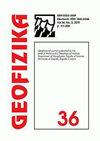Geodetic and seismological analysis of the CROPOS ZAGR station kinematics during the Zagreb 2020 ML 5.5 earthquake
IF 1.1
4区 地球科学
Q4 GEOCHEMISTRY & GEOPHYSICS
引用次数: 0
Abstract
The CROPOS’s ZAGR stations, one of 33 stations of the Croatian permanent GNSS (Global Navigation Satellite System) network CROPOS (Croatian Positioning System), is located in Zagreb’s city centre. For the first time, motion of one of the CROPOS stations (the ZAGR station) during an earthquake shake (the Zagreb 2020 ML5.5) was analysed by the PPK (Post-Processed Kinematic) method using all available GNSS signals (GPS – Global Positioning System, GLONASS – GLObalnaya NAvigatsionnaya Sputnikovaya Sistem, Galileo, Bei-Dou) and seismologically interpreted. The ZAGR station is situated about 9 km to the south-southeast of the earthquake’s epicentre. The analysis showed that the station’s movements, i.e. combined surface and building motion, during the shake was far above the noise level and enabled the assessment of the station’s kinematics: movements in the range of approx. 13 cm in direction north–south (N–S) and approx. 6 cm in direction east–west (E–W). However, movements in the vertical direction were slightly above the noise level. Even though the ZAGR station kinematic behaviour was pronounced, no permanent displacement was identified. The seismological analysis showed that the ZAGR station recorded the onset of the SV-waves on the N–S component, surface waves on the N–S (predominantly Rayleigh waves) and E–W (mainly Love waves) components. The resolution of 1 s of the results of the PPK method have enabled a thorough analysis of the ZAGR station kinematics and pointed out the usefulness of the method in earthquake observations.2020年萨格勒布5.5级地震期间CROPOS ZAGR台站运动学的大地测量和地震学分析
克罗地亚卫星定位系统的ZAGR站位于萨格勒布市中心,是克罗地亚永久性GNSS(全球导航卫星系统)网络CROPOS(克罗地亚定位系统)的33个站之一。首次通过PPK(后处理运动学)方法,使用所有可用的GNSS信号(GPS–全球定位系统、GLONASS–GLObalnaya NAvigatsionnaya Sputnikovaya系统、伽利略系统、北斗系统)和地震学解释,分析了其中一个CROPOS站(ZAGR站)在地震震动(萨格勒布2020 ML5.5)期间的运动。ZAGR站位于震中东南偏南约9公里处。分析表明,在摇晃过程中,车站的运动,即地面和建筑物的组合运动,远高于噪音水平,并能够评估车站的运动学:南北方向(N–s)的运动范围约为13厘米,东西方向(e–W)的运动范围约为6厘米。然而,垂直方向的运动略高于噪音水平。尽管ZAGR站的运动学行为很明显,但没有发现永久位移。地震学分析表明,ZAGR站记录了N–S分量上的SV波、N–S(主要是瑞利波)和E–W(主要是洛夫波)分量上的表面波的开始。PPK方法的结果分辨率为1s,可以对ZAGR台站运动学进行全面分析,并指出该方法在地震观测中的有用性。
本文章由计算机程序翻译,如有差异,请以英文原文为准。
求助全文
约1分钟内获得全文
求助全文
来源期刊

Geofizika
地学-地球化学与地球物理
CiteScore
1.60
自引率
0.00%
发文量
17
审稿时长
>12 weeks
期刊介绍:
The Geofizika journal succeeds the Papers series (Radovi), which has been published since 1923 at the Geophysical Institute in Zagreb (current the Department of Geophysics, Faculty of Science, University of Zagreb).
Geofizika publishes contributions dealing with physics of the atmosphere, the sea and the Earth''s interior.
 求助内容:
求助内容: 应助结果提醒方式:
应助结果提醒方式:


